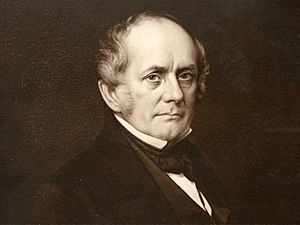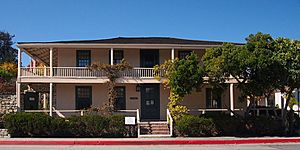Thomas O. Larkin facts for kids
Quick facts for kids
Thomas Oliver Larkin
|
|
|---|---|

Thomas O. Larkin
|
|
| Born | September 16, 1802 |
| Died | October 27, 1858 (aged 56) |
| Citizenship | Mexico, United States |
| Occupation | Merchant, politician, landowner |
| Known for | Only U.S. consul to Alta California |
| Spouse(s) |
Rachel Hobson Holmes
(m. 1833–1858) |
| Parent(s) | Thomas O. Larkin and Ann Rogers |
| Relatives | John B. R. Cooper |
Thomas Oliver Larkin (born September 16, 1802 – died October 27, 1858) was an important American businessman and diplomat. He was known in Spanish as Don Tomás Larkin. Larkin was the only U.S. consul (a government official who helps citizens and promotes trade) in Alta California when it was part of Mexico. He played a key role in the United States gaining California. After the Conquest of California and the Mexican-American War, Larkin helped write the first Constitution of California in 1849.
Contents
Thomas Larkin's Early Life and Journey
Thomas Larkin was born in Charlestown, Massachusetts. His family had a connection to American history: his grandfather, Deacon John Larkin, provided the horse for Paul Revere's famous ride. Thomas tried different jobs when he was young. At 15, he started learning to be a bookbinder in Boston, but he didn't like it.
In 1821, he moved to Wilmington, North Carolina, and worked as a clerk. He tried to open a store and a sawmill, but he lost money. By 1830, he was struggling financially and returned to Massachusetts. His half-brother, John Bautista Rogers Cooper, lived in California and told him about great opportunities there. So, in September 1831, Thomas decided to sail to California.
Meeting Rachel and Starting a Family
On his long ship journey, Thomas met Rachel Hobson Holmes. She was also traveling to California. The ship stopped in Hawai'i before reaching Monterey in April 1832. Thomas and Rachel later married on June 10, 1833. They had nine children together, but only five lived to be adults.
Thomas Larkin started his own small store in Monterey in 1833. He also built the first "double geared" flour mill on the West Coast. He invested in a sawmill in Santa Cruz. Larkin was a skilled builder. In 1835, he built the first two-story house in California. This house, known as Larkin House, is still standing today and is part of Monterey State Historic Park. He also built the first wharf (a pier for ships) at Monterey harbor. He even helped rebuild the Customhouse, where ships paid taxes.
Monterey was an important port at that time. All foreign ships had to stop there to pay taxes and get permission to trade. This made Larkin's business very successful. He traded with Mexico, the United States, and other countries.
Larkin's Role in Alta California
Thomas Larkin became a very important person in California. He was good at dealing with different leaders and changes in government. Even though he supported Governor Juan Bautista Alvarado, he stayed out of trouble when other foreign residents were arrested. He also loaned money to Governor Micheltorena, but lost it when Micheltorena was removed from power.
Larkin never became a Mexican citizen because it required him to convert to Catholicism. Instead, he renewed his visa every year to stay legally. Since he wasn't a citizen, he couldn't own land directly. So, he got land grants in the names of his children.
Becoming the U.S. Consul
In 1842, a U.S. Navy officer, Commodore Thomas ap Catesby Jones, mistakenly thought the U.S. was at war with Mexico. He landed Marines and took over Monterey. Larkin and William Hartnell helped calm the situation. Jones apologized, and his troops left. This event showed officials in Washington how capable Larkin was.
In 1843, President Tyler appointed Larkin as the first (and only) American consul to Alta California. This meant he was the official representative for the U.S. government in California. The next year, he stopped Britain from trying to take over California. He also helped the Mexican government build a smallpox hospital in Monterey.
When James K. Polk became President in 1845, war with Mexico seemed likely. Larkin hired William Leidesdorff to help him as Vice Consul in San Francisco.
The Bear Flag Revolt and War
In early 1846, Larkin received secret instructions from the U.S. government. He was told to quietly encourage California to separate from Mexico and join the United States. He even tried to go to Mexico City to work out a peaceful agreement, but the U.S. Congress declared war before his letter arrived.
Larkin was talking with General Mariano Vallejo about California peacefully joining the U.S. when the Bear Flag Revolt began on June 14, 1846. A group of Americans, hearing rumors of arrests, captured General Vallejo and put him in prison. This revolt surprised Larkin.
California Becomes Part of the U.S.
On July 7, 1846, Commodore John D. Sloat and his ships arrived in Monterey. His Marines and sailors took over the city and raised the American flag over the Customhouse. A week later, Commodore Robert Field Stockton took command. Stockton appointed John C. Frémont to lead a group of volunteers and "Bear Flag Republicans" called the California Battalion.
Larkin joined the U.S. forces sailing south. By August 13, they had peacefully taken over San Diego and Los Angeles. The Mexican leaders, General José Castro and Governor Pío Pico, fled south. Commodore Stockton made Larkin a Naval agent, and Larkin returned to Monterey.
However, the peace didn't last in southern California. Revolts broke out in Los Angeles, and U.S. troops were forced out. Larkin moved his family to San Francisco for safety. He was later captured outside Monterey while trying to visit his sick daughter. He was held prisoner in Los Angeles. He was finally reunited with his family after the Treaty of Cahuenga ended the fighting. Sadly, his daughter died while he was a captive.
Life in the United States
Now that California was part of the United States, Larkin could legally own land. He focused on new business chances. He partnered with Robert B. Semple to start the city of Benicia. But Larkin's main business was in San Francisco, so he sold his share in Benicia after a few years.
When gold was discovered in California, Larkin was living in San Francisco. He made a huge fortune from the economic boom that followed the California Gold Rush. He represented San Francisco at the 1849 Constitutional Convention in Monterey, where California's first constitution was written.
Later Years and Wealth
In early 1850, Larkin built the first brick building in San Francisco. Later that year, he and his family moved to New York. They bought a large, beautiful home and were known for their generous hospitality. However, the cold, damp weather in New York made them sick. Thomas became very ill, and newspapers even mistakenly reported his death.
In May 1853, they returned to San Francisco, and their health improved. They found good schools for their children and continued their busy social and business lives. They built a grand mansion and enjoyed the improvements in San Francisco. During this time, Larkin tried to get money from the U.S. government for supplies he claimed to have provided and for work on the Monterey Customhouse and wharf, but he was not successful.
Larkin bought several large pieces of land, called ranches, including Rancho Jimeno, Rancho Boga, and Rancho Cotate. In his final years, Larkin bought and sold a lot of land. Some people thought he was the richest man in America.
Thomas Larkin's Death
On October 27, 1858, Thomas Larkin was in Colusa, California. He caught typhoid fever, a serious illness, and died within a week. He was first buried in San Francisco. Later, his remains were moved to Cypress Lawn Memorial Park in Colma, California.
Larkin's Family
Thomas Larkin married Rachel M. Hobson. She was born on April 30, 1807, in Ipswich, Massachusetts, and died on October 29, 1873, in San Francisco.
Their children were:
- Isabel Ann (born January 1833 in Santa Barbara – died July 1833)
- Thomas Oliver, Jr. (born April 13, 1834, in Monterey – died July 1898 in San Francisco). He was known as the first white child born to American parents in California.
- William Rogers (born August 25, 1835 – died January 6, 1836 in Monterey)
- Frederick Hobson (born December 23, 1836 – died May 14, 1869)
- Henry Rogers (born May 26, 1838 – died November 18, 1838 in Monterey)
- Francis Rogers (born January 28, 1840 – died July 7, 1874 in San Francisco)
- Carolina Ann (born March 24, 1842, in Monterey – died 1891). She married William Lindzey Hamilton and later William Sampson Tams.
- Sophia Adeline (born June 20, 1843 – died November 28, 1846 in San Francisco)
- Alfred Otis (born April 10, 1847, in Monterey)
Larkin's Legacy
The Larkin House in Monterey is a very important historical site. It is a National Historic Landmark and a California Historical Landmark. A street in San Francisco, Larkin Street, is named after him. An elementary school in Monterey was also named for him, but it is now closed.
Images for kids
-
Larkin's grave at Cypress Lawn Memorial Park, Colma, California




